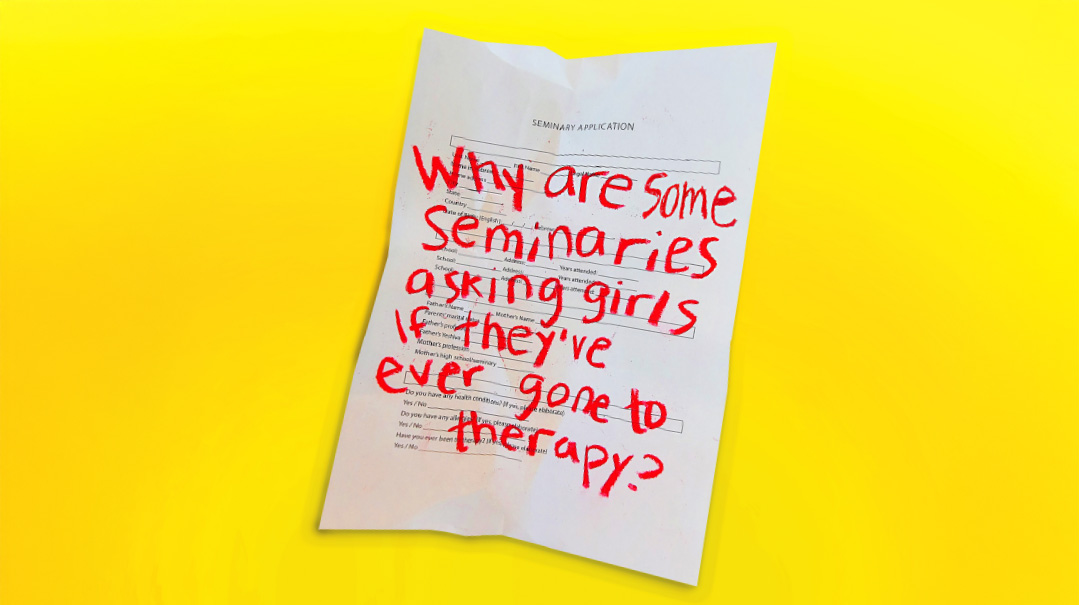Sea Change: The Conversation Continues

The shidduch initiative: the Novominsker Rebbe weighs in

The new shidduch proposal outlined in Issue 1054 has elicited a wave of reactions. Many voiced enthusiasm and optimism, but there were many who expressed concerns, doubts, and questions. Here is a sampling of some of those responses, followed by the perspective of the Novominsker Rebbe (Rav Yisroel Perlow), one of the gedolim intimately involved in the initiative’s development, who shared much-needed answers, thoughts, and clarifications.
Let the Boys Jump First › Rochel Levy, Woodmere, NY
I read with great interest the article about the “girls’ freezer” and shared it with the 12th graders in my public speaking class at Tichon Meir Moshe (TMM) High School in Far Rockaway.
Many were confused. Here we are spelling out a disaster that’s been 20-plus years in the making… and then asking our girls to be Nachshon.
There were six yeshivos listed as willing to send their bochurim to Eretz Yisrael earlier, and I’m sure it was a very weighted decision on their part.
Yet on the other side of the mechitzah, we’re asking hundreds of individual girls to weigh this same monumental move. The feedback from our high school seniors was: We want to do the right thing, but this feels so beyond our scope!
I wonder if the plan can be rolled out in phases. The adjustments on the boys’ side will only yield change in two years. At that point, the girls would be more confident turning away potential shidduchim if they knew a system was already in place. Can the boys be Nachshon and the girls will follow their lead b’tzniyus?
Our bnos Yisrael want to do the right thing and they will. But they’re also afraid of ending up on the wrong side of the equation. They’re ready to dive into the turbulent waters headfirst, but they need the boys to be ready and waiting out at sea in order to make the jump.
Get the Boys on Board › Name Withheld
The article about the efforts of gedolei Yisrael to solve the shidduch crisis raised a lot of hope, but I’d like to bring up a few important points. As the article points out multiple times, the gedolim have been trying to implement this for several years. Even Rav Moshe Hillel Hirsch’s directive, which was supposed to be universally accepted, is almost two years old. Despite that, as the article pointed out, bochurim have been going to Eretz Yisrael even later than in the past. Only six yeshivos were listed as having tried to change this, and this has also yielded only minor changes.
I think the time has come to take the campaign to a broader level. Since the bochurim are in yeshivos, the yeshivos should be the solution. It isn’t possible to solve the problem if the system demands this many years in yeshivah before marriage. Perhaps boys shouldn’t go to Israel at all? They definitely shouldn’t come home at 23.
The word of our gedolim is law, and I hope to see that law implemented soon.
Unprecedented Move › Chaya B. Ehrman
As a shidduch counselor for several decades, I’d like to raise some questions about the proposed shidduch initiative.
From recent comprehensive conversations with leading rabbanim and roshei yeshivah, (all participants in the recent asifos), it appears that several core discerning insights seem to be missing from the report.
To be sure, every rav wishes that we could successfully narrow the age gap. But not all gedolei harabbanim are comfortable with the idea of an unforgiving, constrictive edict that puts the girls in a “freezer” of their own. Many rabbanim are not completely comfortable with the idea of issuing a wide-reaching, social engineering gezeirah on a tzibbur comprising hundreds of thousands of individuals. Unlike a chassidus, yeshivah kehillos aren’t a single homogenous entity. An initiative like this, that restricts a broad swath of the population, is unpreceded in recent centuries.
Additionally, why are the girls being asked to bear the brunt of the change? Why is there no discussion of BMG easing its freezer policy, perhaps specifically for boys willing to meet “older” girls? Why are leading roshei yeshivah not initiating and encouraging a post-beis medrash option in the US that would allow for immediate entry into shidduchim? Many boys would likely forgo beis medrash in Eretz Yisrael if they had a superb local option.
Many rabbanim and roshei yeshivah are wondering if rather than seeking the broad — but unlikely — consensus of many hundreds of rabbanim to initiate a historic ban, it wouldn’t be wiser to aim for a declaration from just a few dozen roshei yeshivah, notifying their talmidim, the parents of their talmidim, and shadchanim that they will be doing their utmost to discourage their respective talmidim from pursuing shidduch suggestions with young ladies straight out of seminary.
It need not be a momentous injunction; it need not be an indefinite sanction, and it need not be one that leaves no room for the necessary exemptions.
Age Isn’t All › Peretz Perl
The age-gap theory (AGT) and its basic building blocks (spousal age difference and population growth rate) are familiar territory to those following this discussion for about 20 years now. As an actuary myself, I agree there is little doubt that the effect exists. I’m less convinced that it can bear the full burden of the explanatory weight that has been heaped on it.
On a desert island with an experimentally controlled population, the results that have been projected might be realized. But our real world is far more complex. As your article acknowledges, other factors have been identified, but few, if any, have attempted to measure these elements or can even define how to measure them. Do we perhaps have a communal bias toward promoting the AGT as the primary reason behind the shidduch crisis because it places the blame on cold impersonal demographic phenomena while avoiding the candor we might need to deal with communal behaviors and habits we may have normalized that have exacerbated some of the other factors the article mentioned?
I do believe the AGT is conceptually sound and that efforts to shrink the gap are not only well-intentioned, but well-placed. But we may be a little too eager to want the age gap to be the one-stop answer to this challenge. I suggest that we simultaneously ask ourselves whether we’re devoting enough time, thought, and resources to candidly address other potential causes.
Not Just a Numbers Issue › Rabbi Eliezer Shore, Jerusalem
I was disappointed to read that the proposed solution to the shidduch crisis was a 20-year-old solution that hasn’t been proven to work.
An in-depth look at the numbers will show that demographics alone aren’t the heart of the problem. We need to also address it on the personal and social levels — unrealistic expectations of our youth, excessive financial demands on parents, unpreparedness for marriage, and a host of other issues.
While it’s true that closing the age gap will alleviate the situation somewhat, it will not solve the problem, which cannot be reduced to mere numbers.
Off the Cuff Rejections › Eliezer Cohen
In regard to the new shidduch initiative, I hardly believe that adjusting the age gap will be enough to achieve real progress. In my humble opinion and discussions with parents who have young women in the parshah, some of the other contributing factors that were mentioned as an aside are really more crucial.
A major issue that was only mentioned tangentially is unrealistic expectations, which is a major problem on both sides of the equation. This imaginary perfect spouse is an obstacle to getting married. Nobody checks all the boxes. An open mind is necessary, and offhanded rejection of suggestions may lead one to dismiss their bashert. Singles must be willing to at least meet suggestions, even if just for a simple cup of coffee. You cannot reject someone based on a résumé.
As Rabbi Riskin said nearly 50 years ago during one of his famous Wednesday night lectures, “You may be sitting in the room with your bashert. Don’t let the opportunity be lost.”
Exploring the Pushback › Akiva Klienberg
I’ve seen a few letters both in this magazine and in other forums raising concerns and opposition to the proposed changes to the shidduch system. While admittedly this isn’t necessarily the perfect solution, and there are other issues that need addressing as well, right now, this is what our rabbanim have suggested, and it’s silly to stop the momentum because the solution isn’t perfect. In the past 20 years there’s been a lot of talk about the shidduch crisis but little action. It stands to reason that if this plan can be implemented successfully, it will lead to other productive initiatives. Spreading cynicism risks sabotaging not only this plan but any movement toward other goal-oriented initiatives.
Many people have expressed disapproval at the idea of institutionalizing something as personal as when people start shidduchim. What they fail to realize is that the proposal isn’t creating a system in a place where there isn’t one; it’s simply trying to address the flaws of an existing system. If we have a system, let it be one that works.
Others have pointed out that using terms like “the shidduch crisis” and otherwise playing up this issue is hurtful to our singles. While they’re certainly correct, the catch-22 at hand is that motivating change requires accentuating the current problem. There’s no easy answer, but perhaps understanding the dynamics at hand will make this easier to swallow.
I also believe that a lot of the opposition to this plan comes from people who may not have children in shidduchim, or whose children are just starting, or people from different communities altogether who aren’t familiar with the nuances of the American yeshivish shidduch system. The common denominator is that all these people aren’t personally familiar with those who have been deeply hurt by the current system, and therefore don’t understand the urgency of trying to come up with solutions.
Trust Hashem’s Timing › A Young Lady in Shidduchim
I want to start by acknowledging my utmost respect for the gedolim quoted in the article about the shidduch “crisis” and the invaluable work they do for Klal Yisrael.
I’d also like to offer a slightly different perspective on this issue that I feel was overlooked: the role of Hashem in the shidduch process.
The article focuses primarily on statistics and numbers but fails to acknowledge the fundamental truth that shidduchim are ultimately in Hashem’s hands. Yes, it’s important to engage in hishtadlus and create a vessel for Hashem’s shefa to flow, but since when has the process of finding one’s zivug become a crisis? Where is Hashem in all of this?
One of the rabbanim mentions that only 30 girls in his 22-year-old granddaughter’s class of 67 are married. But is it possible that some women are simply meant to marry later? That waiting longer is part of their individual journey and nisayon in life?
When couples struggle to have children, do we call it a fertility crisis? When someone is diagnosed with cancer, do we call it a cancer crisis? Why is there such an inconsistency when it comes to shidduchim? The tone of the article was almost catastrophizing, suggesting that if the age gap isn’t closed, a large percentage of girls will remain single.
I believe we can address this issue more internally by reducing the stigma around age and timing. Instead of perpetuating the notion of a shidduch crisis, let’s focus on fostering an environment where singles are supported. Trusting in Hashem’s timing and accepting that some may marry later than others could alleviate much of the unnecessary pressure and fear surrounding the shidduch process.
People Aren’t Statistics › Lea Pavel
Last week’s article regarding the plight of singles left me a tad confused. I would say the age gap isn’t the problem; it’s ageism. There appears to be a tiny window acceptable for a girl to be single — after 21, she’s in crisis. But the boys? At what age is a boy in crisis? 25? 30? 40? At what point does his marriage get classified as “a miracle”?
I know of more than one woman who is 22 and has chosen not to start dating yet. I applaud them. Because girls are not automatically more ready for marriage at 20 than boys are — as depicted in the recent serial Picture This.
Is the article suggesting that for a woman to marry over the age of 23 requires a miracle? Aren’t all marriages bashert? Or do we believe that we can manipulate the Divinely orchestrated?
My husband and I entered the dating field the same year — I at 19 and he at 23. However, we didn’t meet until we were both in our thirties. Same “problematic” age gap, now “acceptable” 12 years later.
Some believe that my shidduch was delayed for human reasons; I believe that Hashem decided that we required a later time slot.
Ultimately, a shidduch is between two people, not two statistics. I would argue that hyperbolic language such as “single women over the age of X require a miracle” reflects an upsetting lack of anivus and emunah. Hashem is running the show — not us.
Bitachon and Hishtadlus Are Inverse › Sara O.
Several contributors to the discussion about the shidduchim initiative wondered where bitachon factors into this discussion about numbers. Bitachon and hishtadlus are like two sides of a scale; when there is more of one, there tends to be less of the other. Realistically, it’s fair to say that most people don’t operate with 100 percent bitachon. Therefore, we can’t ignore the necessity of doing our part through hishtadlus.
I truly believe that following the guidance of our rabbanim is the correct form of hishtadlus. By having emunas chachamim, we can be confident that we won’t lose out. At the same time, perhaps there is room for additional hishtadlus, particularly when it comes to addressing the maturity levels of the boys in our community.
It Starts in Preschool › Name Withheld
Thank you for a very informative article on the shidduch crisis. As a mother of a daughter in shidduchim, I appreciate the challenges and am eager to see change.
I wanted to express concern about what I believe was a glaring omission regarding one of the causes of the problem and an easy solution to partially alleviate the age gap.
My oldest and youngest sons are both “borderline” babies, born just before the school cutoff for admissions. In both cases, the school pressured us to leave them back. In hindsight, this was a poor decision for many reasons, one of them being that my older son will be going to Eretz Yisrael as a 22-and-a-half-year-old.
I believe it’s crucial to reexamine if we are unnecessarily holding back borderline children. Our child is not the only one — we know of many in the same situation.
It would behoove those involved in making changes to reduce the age gap to consider how the preschool years play a role in this crisis.
The Change Is Happening › Name Withheld
I found it very ironic that the article about the shidduch initiative framed the phenomenon of girls still single a few years out of high school as a disaster. The main thrust of the article was that the shidduch crisis is caused by the age gap between boys and girls in shidduchim and posited that the solution is for girls to get married older or for boys to get married younger.
It seems to me that seeing that girls are getting married older is something to celebrate; the age gap is closing. Hashem is orchestrating the solution for us, but we are calling the solution “a disaster.”
Talk to the Shadchanim › Name Withheld
As 23-year-old young woman with a 20-year-old sister, I read the shidduch article with interest, but felt it wasn’t addressing the ones who are key to instituting such a change: the shadchanim.
The way I see it, the only way to keep boys and girls from dating before they reach a certain age is if the shadchanim agree not to set them up.
Status Quo › Daniel Steinberg
I’d like to respond to the mother who was concerned that holding her daughter back from dating before Rosh Chodesh Nissan would make her a “korban tzibbur.” I think it would be helpful to consider this initiative notwithstanding, about 95 percent of girls are anyway still single come Nissan their first year out of seminary. In other words, formalizing this simply preserves a status quo while helping to level the playing field. In the rare event you do receive a suitable suggestion in this six-month window, you can ask your own daas Torah.
Obviously, as this idea gains traction, hopefully boys will not be dating girls this young.
Rav Yisroel Perlow
L’acheinu Bnei Yisrael,
Many questions have been asked, and for the most part they seem to fall within five general areas of concern.
1
Over the years, numerous issues have been identified as contributing to the crisis. Why, then, is singular emphasis being placed on the age gap? Shouldn’t equal attention be given to the other factors as well?
We do not deny that there are a number of factors contributing to the shidduch crisis. The article, in fact, made mention of some of these, including unrealistic expectations, logistical difficulties for girls living out of town, a dearth of shadchanim, and hashkafic misalignment. We acknowledge all of them.
Despite this, it must be made clear that first and foremost, the age gap must be resolved. We will explain this with an analogy. Suppose you have a room in which 100 people wish to gather. The room, however, has only 80 seats. Math demands that 20 people will be left standing. Now, you can have courses, coaching sessions, workshops, and inspirational speeches, all geared toward training people on how to efficiently find a seat, but it won’t help. If the numbers don’t work, then nothing does. A first step has to be to add 20 chairs to the room. When that happens, all other methods and techniques will begin working.
We would be thrilled to see progress in resolving the many layers of complexity in the shidduch crisis. But until the numbers are evened out, the conversation lacks relevance.
2
The article portrays this proposal as the de facto position of the leading Torah authorities. If this is so, then why has its implementation not become official policy?
The days when we had a Sanhedrin to issue definitive rulings have long since passed. Today, we turn to our gedolim for direction, which they generously provide. Does this allow us to sentence those who do not comply to makkos mardus (a punishment administered to those who violate rabbinic prohibitions)? No, it does not.
Ultimately, we believe that when the tzibbur perceives the benefits of this transformation and the steep repercussions of inaction, the path toward implementation of the rabbanim and roshei yeshivah’s guidance will naturally be paved.
3
The most basic concept in Judaism is that Hashem runs the world. This is true for every aspect of living. If anything, shidduchim should see even greater Hashgachah, as the Midrash says, Hashem is “yosheiv u’mezaveg zivugim.” Why, then, is the attitude that our efforts, based on mathematical calculations, can affect decisions so obviously governed by Divine Providence?
This is an excellent question. The Gemara uses the term “b’hadi kavshi d’Rachmana lama lach — why must you involve yourself in the secrets of Hashem?” This crisis evolved over the course of decades, systemic and social trends broadening the age discrepancy and leading to the current disaster.
Why did Hashem allow this to happen? Why didn’t He, in His infinite Knowledge put an immediate stop to it? One cannot know. But what we do know is that when faced with a tzarah, we must work with the derech hateva — along with tefillah, emunah, and bitachon — to see to its resolution.
Think back to the terrifying barrage of missiles Iran fired at Eretz Yisrael earlier this year. Yes, we davened for protection. But we also ran for shelter. When presented with a predicament, Hashem wants us to act b’derech hateva in addition to our tefillos and bitachon.
Right now, we have a crisis. To simply sit back and say “all we must do is daven” is simply irresponsible and hashkafically misguided. Hashem expects us to do what we can al pi derech hateva, and that is precisely what we are attempting to do.
4
The proposal addresses both boys and girls, but it does not appear balanced. Girls are being told to accept a comprehensive no-dating policy for one year after seminary. Boys are being advised to leave for Eretz Yisrael a year earlier, but the tone is less certain. Will all roshei yeshivah comply with this? There is no guarantee. So while 100 percent of girls are expected to participate, there doesn’t seem to be the same expectation on the boys’ end. How is that fair?
Let us answer this question in two parts. First, from a conceptual perspective, is it our position that the onus should be placed more on the girls than on the boys? Of course not. Rav Moshe Hillel was abundantly clear that this effort must come from both ends, and that is what we are aiming for.
Second, from a practical perspective, will this proposal ultimately result in greater compliance from girls than boys? We can’t predict the long-term outcome, but in the short term, yes, this is possible. The reality is that boys, who operate within a yeshivah setting, will follow direction from their roshei yeshivah. Not all roshei yeshivah have expressed their commitment to the proposal, and thus, not all boys will be following it. But many will, and our expectation is that this number will grow.
We must also bear in mind the words of Rav Elya Brudny, quoted in the article, in which he raised the general concern with girls dating immediately after seminary. Now is not the time to expound on the severity of the issues in this regard, but the concern is shared by many leading rabbanim and mechanchim. This, too, is an important factor in the focus on the girls’ participation in this endeavor.
A final thought to consider is that perfectionism can be our greatest enemy. Even if it’s true that we will not achieve 100 percent success on the boys’ end — should that deter our ambition to achieve 100 percent success on the girls’ end? Every bit of progress is one step closer to evening out the numbers, and one step away from the bitterness prevailing in the shidduch market today.
5
The proposal seeks, at best, to address the shidduch crisis going forward. But should that be the focus of our attention? What about the thousands of girls already in shidduchim? Aren’t we betraying them by making all our efforts about the future while failing to address the past — and painful present?
Not a moment goes by in which this question doesn’t weigh on the hearts of the rabbanim and roshei yeshivah like a thousand tons of cement. The cries of these countless girls pierce the very Heavens; there is no doubt that Hashem is crying along. Imo Anochi b’tzarah — Hashem feels the pain more than anyone can imagine. But to respond to the question, the reality is that this initiative does, in fact, help those already in shidduchim. Postponing the start of shidduchim for girls means there are fewer girls on the market at any given time. The fewer girls there are, the less competitive the market becomes. Twenty-two-year-old girls will no longer be competing with 18-year-old girls for shidduch suggestions. So the benefits here are manifold.
But speaking to the concern more generally, it is the cry of our sisters that prompted us to take such dramatic action in the first place. As to why our focus is on the girls entering the parshah and not those already in it, again, we will draw an analogy. If there is a forest fire, the first step must be to contain the fire. Only then can the focus shift to putting the fire out. Right now, our focus is on creating a systemic change. If we are to allow a broken system to run rampant, then the fire will never be extinguished.
Hopefully in the near future, we will be able to turn our focus toward finding resolutions for the many already in need of a yeshuah. Rav Elya Brudny, quoted in the article, said it best. In the merit of our efforts, Hashem will have rachmanus on us and we will see yeshuos well beyond what this initiative strives for. Amen, kein yehi ratzon.
To conclude with a point that may sound self-aggrandizing but is an important one to be made: The rabbanim and roshei yeshivah who have invested heart, soul, and thousands of hours into this effort have, suffice it to say, other things to do with their time. It would not be an exaggeration to say that they are among the busiest people in the world. Their phones don’t stop ringing, people constantly knock on their office doors, and all this is in addition to family life and, of course, their own learning sedorim.
That they have taken upon themselves to hold numerous meetings and travel to multiple cities, all for the sake of easing the shidduch crisis is, in itself, the most remarkable feature in this entire endeavor. The many concerns may be justified but must not intrude upon the respect and admiration owed to these valiant leaders of our community.
On behalf of all those involved in this avodas hakodesh, I would like to conclude with a heartfelt brachah to everyone in shidduchim, boys and girls. May Hashem send you your zivugim hagunim b’karov mamash.
May you see only simchah, and only simchah, in your lives.
Nothing could make us happier.
(Originally featured in Mishpacha, Issue 1057)
Oops! We could not locate your form.







